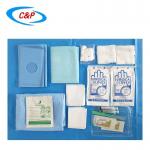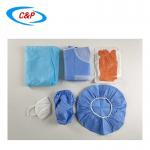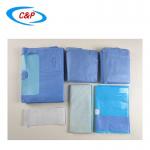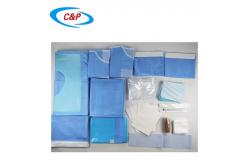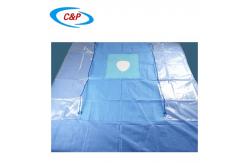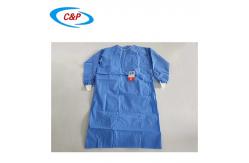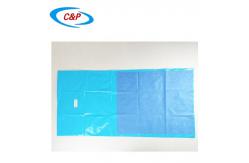Product Description:
Hip drape pack is a specialized disposable surgical pack used in
hip replacement surgeries or other hip-related procedures. It
contains a collection of sterile drapes, towels, and other
accessories that are used to create a sterile field and cover the
patient and surrounding areas during the surgery.
Hip drape pack is an essential tool for preparing a patient for hip
surgery and ensuring a successful recovery. It helps to ensure that
all necessary items are available during the procedure and recovery
period, reducing the risk of complications and improving patient
outcomes.
Technical Parameters:
| Product Category | Disposable Surgical Pack |
| Sample | Freight Collected |
| Material | SMS, PP, PE, Spunlace Non-woven Fabric |
| Application | Hospital And Clinic |
| Certificate | CE&ISO13485 |
| Efficiency | Allows for quick and efficient setup before a procedure |
| Feature | Soft, Procedure, Convenient, Waterproof |
| Sterility | Individually packaged in sterile bags |
| Infection Control | Key component of standard infection control practices |
| Detail | 4pcs Hand Towel 1pc X- Ray Bag 50x60cm 2pcs OP Tape 10x50cm 1pc Skin Marker 1pc Reinforced Surgical Gown L 1pc Stockinette 40x75cm 1pc Reinforced Surgical Gown XL 1pc Elastic Bandage 10x 1 50cm 1pc Wrap Paper 100x 100cm 1pc Hip Surgery Drape 150x300cm 1pc Anesthesia Drape 1 50x220cm 10pcs Gauze 10x10cm 1pc Mayo Stand Cover 76x145cm 2pcs Side Adhesive Drape 75x90cm 1pc Back Table Cover 150x200cm |
Pictures:
Features:
The features of a hip drape pack are designed to provide a sterile
and safe environment for hip surgery, ensuring the best possible
outcomes for patients. Here are some key features that you might
find in a disposable surgical pack:
Key Features of a Hip Drape Pack:
1. Sterility: The drapes and all other components of the disposable surgical pack are sterile to prevent infection during surgery. They are
typically packaged in a way that maintains their sterility until
use.
2. Adhesive Border: Many surgical drapes have an adhesive border to
secure them to the patient's skin, preventing them from shifting or
moving during the procedure.
3. Waterproof Material: Drapes may be made from waterproof
materials to prevent fluids from leaking through and contaminating
the surgical field.
4. Elasticity: Some drapes have elastic edges to conform to the
patient's body without causing discomfort or pressure on the hip
area.
5. Breathability: To reduce the risk of complications, the drapes
are designed to be breathable, allowing air to circulate around the
wound.
6. Fenestration Options: Fenestrated drapes with windows or holes
may be included to allow access to specific areas of the hip
without compromising the sterile field.
7. Size and Shape Variety: Drapes come in various sizes and shapes
to accommodate different types of hip surgeries and patient needs.
8. Labeling: The drapes and other components of the disposable surgical pack are clearly labeled with the size, type, and any specific
features, such as fenestrations for certain procedures.
9. Packaging: The drapes and other items are packaged in a way that
maintains their sterility until use and is easy to open without
contaminating the contents.
10. Compatibility: The drapes and other items in the disposable surgical pack are designed to be compatible with other surgical instruments
and equipment used during hip surgery.
Overall, a hip drape pack is designed to provide a sterile and safe
environment for hip surgery, minimizing the risk of infection and
maximizing patient outcomes.
Applications:
The hip drape pack is a specialized disposable surgical pack that
is used in various types of hip surgeries to maintain a sterile
surgical field and ensure the best possible outcomes for patients.
Here are some key applications of a hip drape pack:
Applications of a Hip Drape Pack:
1. Total Hip Replacement (THR): During a total hip replacement
surgery, the disposable surgical pack is used to create a sterile
field around the surgical site. The drapes help to isolate the area
from potential contaminants and reduce the risk of infection.
2. Hip Arthroscopy: In minimally invasive hip arthroscopy
procedures, the disposable surgical pack is used to maintain a
sterile environment while the surgeon accesses the hip joint
through small incisions.
3. Hip Fracture Repair: When repairing hip fractures, the
disposable surgical pack is essential for maintaining a sterile
field and preventing infection during the procedure.
4. Hip Resurfacing: In hip resurfacing procedures, where the
surface of the hip joint is replaced instead of the entire joint,
the disposable surgical pack helps to maintain sterility and
minimize the risk of complications.
5. Hip Biopsy: During a hip biopsy, where a small sample of tissue
is taken for diagnostic purposes, the disposable surgical pack
ensures a sterile field and reduces the risk of infection.
6. Hip Arthroplasty: In hip arthroplasty procedures, where parts of
the hip joint are replaced or resurfaced, the hip drape pack is
crucial for maintaining sterility and ensuring the best possible
outcomes for patients.
7. Hip Osteotomy: During hip osteotomy procedures, where bones are
cut and reshaped, the disposable surgical pack helps to maintain a
sterile field and prevent infection.
8. Hip Labral Tear Repair: In procedures to repair labral tears in
the hip, the disposable surgical pack is used to maintain sterility
and minimize the risk of complications.
9. Hip Capsulotomy: When performing a hip capsulotomy, where the
hip capsule is opened to access the joint, the disposable surgical
pack ensures a sterile field and reduces the risk of infection.
10. Hip Exposure: In surgeries where the hip joint needs to be
exposed for various reasons, the disposable surgical pack helps to
maintain a sterile field and prevent contamination.
Overall, the hip drape pack is an essential tool for any type of
hip surgery, providing a sterile and safe environment for both the
patient and the surgical team. By minimizing the risk of infection
and other complications, the hip drape pack helps to ensure
successful outcomes for patients undergoing hip surgery.
Customization:
Understanding the specific needs and preferences of individual
medical facilities or surgeons is crucial in providing an effective
customized service for disposable surgical packs. Here are some key
features that can be customized:
1. Pack contents: The disposable surgical pack can be customized to
include specific instruments, supplies, and materials that are
required for a particular procedure or surgery.
2. Material: The materials used in the disposable surgical pack,
such as the type of fabric or plastic used for the drapes and
sheets, can be customized based on the preference and requirements
of the medical facility or surgeon.
3. Size: The size of the disposable surgical pack can be customized
based on the type and complexity of the procedure, as well as the
size of the surgical team.
4. Labeling: The labeling of the disposable surgical pack can be
customized to include specific information about the contents of
the disposable surgical pack, such as the name of the procedure or
surgery and the date of expiration.
5. Packaging: The packaging of the disposable surgical pack can be
customized based on the preference and requirements of the medical
facility or surgeon, such as the type of container used for the
disposable surgical pack or the method of sterilization.
6. Delivery: The delivery of the disposable surgical pack can be
customized based on the schedule and location of the procedure,
such as direct delivery to the operating room or sterile field.
Overall, customizing disposable surgical packs can help improve
efficiency and reduce waste during surgery by ensuring that the
pack contains only the necessary instruments, supplies, and
materials required for the procedure. It can also help reduce the
risk of cross-contamination between patients by ensuring that the
disposable surgical pack is sterilized and packaged according to
specific standards.
Packing and Shipping:
Product Packaging:
The disposable surgical pack is packaged in a sterile, sealed plastic bag to ensure cleanliness
and safety. The bag is labeled with the product name, lot number,
and expiration date.
Shipping:
The disposable surgical pack is shipped in a sturdy cardboard box to prevent damage during
transportation. The box is labeled with the product name, quantity,
and shipping address.


